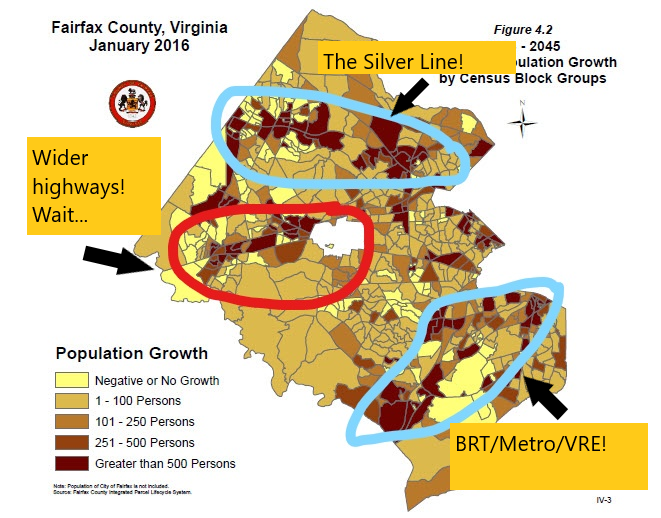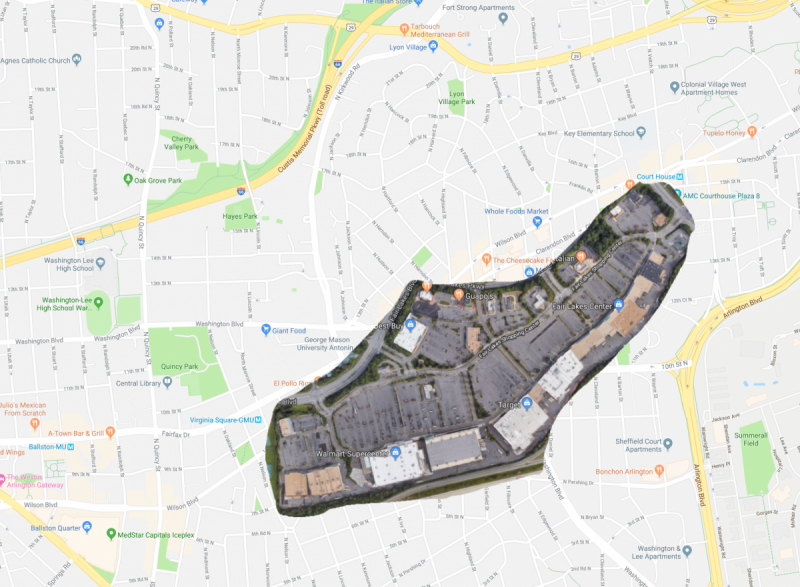Lots of Fairfax communities are emphasizing transit and walkability. Why not Fair Oaks?

The area known as "Fairfax Center". The Fairfax County Government Center is on the left side of the picture while Fair Oaks Mall is on the right. Image by Google used with permission.
Fairfax is a big county with big plans. New transit lines accompanied with ambitious land use plans aim to transform areas like Tysons Corner, Reston, and Herndon in the northern half of the county, while the Embark Richmond Highway Plan is guiding growth in the southern portion.
Right in the middle of the county, west of the city of Fairfax, there’s a large area known as “Fairfax Center” in county planning documents. It’s made up of several smaller communities including Fair Oaks, Greenbriar, and Fair Lakes. Possibly most famous for its eponymous shopping mall, the area about as dense as similar communities in Reston or along Route 1. Fairfax Center is also home to the Fairfax County Government, and the county’s government center and auxillary buildings take up a lot of real estate near the mall.
However, while Reston and Richmond Highway are the focus of specific plans and big ambitions, Fairfax Center’s plans are modest in comparison. The bulk of transportation planning is still focused on widening area highways like Interstate 66 or Fairfax County Parkway.
Fairfax has three dense corridors, but transit plans for one of them is lacking. 
Fairfax Center is still centered around cars
The area entered into a hyperfast stage of growth in the late 1980s when Fair Oaks Mall opened and Fairfax County built its new headquarters for county government. Roughly sandwiched between highways 29 and 50 with I-66 running down the middle, growth in the area exploded. Today it has a wide variety of homes ranging from small apartments to townhomes to single-family homes.
That meant a lot of affordable places to live were built. However, the typical car-centric planning meant that even though lots of people were living closer to jobs and shops, most people drove. That led to the cycles of widening roads that still continue today.
That’s not that different from other areas of Fairfax, but while the county is being active about bringing transit to northern and southerns parts of the county and changing the land use to create more walkable communities, plans in the middle are still largely car-focused.
For example, new HOT lanes along I-66 are currently underway. That project comes with the promise of more transit and room for a possible extension of Metro’s Orange Line, but those plans are still far off. What’s happening right now is road construction.
Townhomes near Fair Oaks mall. Image created with Google Maps. 
The area needs more places for people to walk and hang out
As the home to the main headquarters of the Fairfax County government, Fairfax Center has a large government presence. But that’s not all. VDOT’s Northern Virginia headquarters is just off of West Ox Road, sandwiched between a major bus garage used by WMATA and Fairfax Connector and Fairfax County’s Fire Training Academy. There’s also a major landfill and recycling center just off of West Ox Road.
A listing of public facilities in Fairfax Center. This doesn't include parks, but the comp plan says that local parks are "deficient" for the number of residents today. Image by Fairfax County.
Despite the large government presence, there is a distinct lack of civic space available for regular people to use. Local parks are “deficient” in size and access, according to county planning documents. The nearest “public” square is the fountain at the Fairfax Corner development, and it’s a popular spot, especially in summer when the fountain is running for anyone looking to cool off. However, the overall lack of public space for people to gather is an impediment to creating places that provide density without being overwhelming.
Grounds around the government center are open and bucolic, but the campus-like nature of the center combined with wide roads makes access harder than it ought to be. The only library is an auxillary branch located in the Government Center which is focused on getting books to people who need accommodation (like books in Braille or home delivery). These are important, but hours and overall services are still limited compared to the otherwise-large library system.
There are public events at the Square in Fairfax Corner. Image by Google Street View used with permission.
Compare that to the uber-sized Fair Lakes Shopping Center, where a long line of big box stores stretches out far enough to rival major neighborhoods like Ballston or Clarendon in size, but is functionally unwalkable despite large apartment communities literally across the road.
Again, very long term plans suggest a new Orange Line terminal station in the median of I-66. The Comprehensive Plan envisions a mixed-use future for the area, but also calls for more interchanges along area roadways in addition to widening I-66.
Part of the Fair Lakes Retail Area superimposed over the Clarendon Neighborhood in Arlington. Three Metro stations could fit in here. Image by the author created with Google Maps. 
Fairfax Center needs to dream bigger
There are some bright spots. The park-and-ride lot at Stringfellow Road was expanded in recent years to be a hub for express bus service once the I-66 project is complete. When VDOT began tolling portions of I-66 inside the Beltway, that allowed Fairfax County to start up one of those services immediately.
Today the 699 bus runs from the Government Center to downtown DC, giving people another option to take transit to jobs. The area will also get a major trail upgrade as a part of the overall I-66 project, as well functionally extending the Custis Trail. That’s a good thing, despite problems with some of the trail’s designs.
A commercial street in Fairfax Corner. Image by Payton Chung.
Fairfax Center (or whatever you want to call it) just as much potential as anywhere else in Fairfax County, but for some reason it hasn’t gotten the attention other parts of county have in recent years. Part of that might be because the area is doing fine—here’s no blight to speak of, nor serious crime. Nonetheless, that neglect means it’s that harder for the area to transform into more than just a cluster of retail you can drive to.
Tysons, Reston, and Richmond Highway are all seeing the fruits of a long labor coming out in specific plans that prioritized transit and walkable communities. Fairfax Center has many of those same elements to create something great. However, it stays under the radar and is only known for a few shopping centers, rather than being a community. Maybe that should change.
